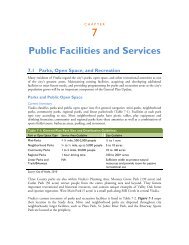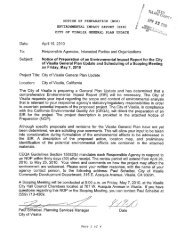General Plan Update Review Committee Draft Elements Part 2 For ...
General Plan Update Review Committee Draft Elements Part 2 For ...
General Plan Update Review Committee Draft Elements Part 2 For ...
Create successful ePaper yourself
Turn your PDF publications into a flip-book with our unique Google optimized e-Paper software.
New structures are required to adhere to current<br />
California Uniform Building Code (CUBC) standards.<br />
(Top)<br />
In the <strong>Plan</strong>ning Area, hazards due to ground shaking<br />
are considered to be low. Damage is most likely to<br />
occur to older masonry buildings. (Bottom)<br />
8-4<br />
VISALIA GENERAL PLAN UPDATE<br />
earthquakes, slip rates on major faults and deformation<br />
throughout the region and the potential for<br />
amplification of seismic waves by near-surface geologic<br />
materials. The resulting earthquake shaking<br />
potential is used in developing building code design<br />
values, estimating future earthquake losses and prioritizing<br />
earthquake retrofit. In the <strong>Plan</strong>ning Area, low<br />
levels of shaking, with less frequency, are expected to<br />
damage only weaker masonry buildings. However,<br />
very infrequent earthquakes could still cause strong<br />
shaking. 3<br />
Ground Failure<br />
Earthquake-induced ground failures, such as ruptures,<br />
lateral spreading, ground lurching, seiches, or<br />
mudslides, are unlikely to occur in the <strong>Plan</strong>ning Area<br />
because of its relatively stable geologic formation and<br />
lack of active faults.<br />
3 California Geological Survey and US Geological Survey,<br />
Earthquake Shaking Potential for California, Map Sheet 48<br />
Revised 2008). 2008. http://www.conservation.ca.gov/cgs/<br />
information/publications/ms/Documents/MS48_revised.pdf<br />
Seismic Safety<br />
Existing structures in the <strong>Plan</strong>ning Area could be<br />
affected by the types of earthquake-induced effects<br />
listed above, but to varying degrees based on length,<br />
intensity, and distance of the earthquake from a given<br />
building. New structures are required to adhere to<br />
current California Uniform Building Code (CUBC)<br />
standards for Seismic Zone 3, providingand provide<br />
adequate design, construction and maintenance of<br />
structures to prevent exposure of people and structures<br />
to major geologic hazards. In particular, any<br />
critical facilities such as hospitals, fire and police stations,<br />
and emergency communications and operations<br />
centers must be adequately designed, constructed<br />
and maintained with the goal of remaining<br />
functional after a large seismic event. The use of flexible<br />
utility connections, building anchors, and adequately<br />
reinforced concrete can reduce the loss of life<br />
and damage to buildings for human occupancy.




